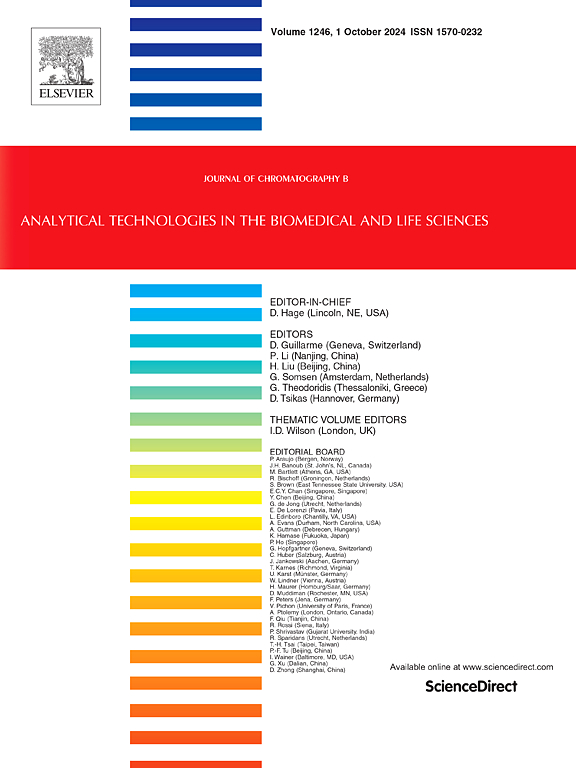Synthesis of 2-methyl-6-methoxy-4-quinolinecarboxylic acid N-hydroxysuccinimide ester (MMQC-OSu) for streamlined and effective HPLC-based fluorescence detection of aliphatic amines in environmental samples
IF 2.8
3区 医学
Q2 BIOCHEMICAL RESEARCH METHODS
引用次数: 0
Abstract
Aliphatic amines are widely distributed in the environment and food sources, posing potential health risks through skin and mucosal irritation. Consequently, their quantitative detection is crucial for assessing environmental health. Despite high reactivity and fluorescence properties of succinimidyl ester-based derivatization reagents, their application in the aliphatic amines detection is hampered by challenges such as limited detection sensitivity and fluorescence interference. We established an innovative synthetic approach to produce a series of succinimidyl esters with the desirable substituents. This advancement enabled the creation of efficient and highly sensitive reagents for the detection of aliphatic amines. Among them, 2-methyl-6-methoxy-4-quinolinecarboxylic acid N-hydroxysuccinimide ester (MMQC-OSu) exhibited the best detection performance. MMQC-OSu reacted with aliphatic amines at 40 °C in pH 8.0 buffer for 20 min, which was subsequently separated in a C18 chromatographic column with the fluorescence detection wavelength of 336/432 nm. This detection approach featured a rapid and mild reaction process, minimal interference from corresponding hydrolysis products, and impressive sensitivity (0.05 nM). These characteristics indicate that MMQC-OSu significantly surpassing commercial aliphatic amines detection reagents. Finally, the detection strategy of MMQC-OSu was successfully applied in environmental sample analysis, with recovery rate of 93 %–108 % and RSDs between 1.4 % and 6.5 %.
合成 2-甲基-6-甲氧基-4-喹啉羧酸 N-羟基琥珀酰亚胺酯 (MMQC-OSu),用于基于高效液相色谱法的荧光检测环境样品中的脂肪胺类化合物
脂肪族胺广泛分布于环境和食物来源中,对皮肤和粘膜有刺激作用,对健康构成潜在风险。因此,对其进行定量检测对于评估环境健康至关重要。尽管基于琥珀酰亚胺酯的衍生试剂具有很高的反应活性和荧光特性,但它们在脂肪族胺检测中的应用却受到检测灵敏度有限和荧光干扰等挑战的阻碍。我们建立了一种创新的合成方法,生产出一系列具有理想取代基的琥珀酰亚胺酯。这一进步使得我们能够制造出高效、高灵敏度的试剂来检测脂肪胺。其中,2-甲基-6-甲氧基-4-喹啉羧酸 N-羟基琥珀酰亚胺酯(MMQC-OSu)的检测性能最佳。MMQC-OSu 与脂肪族胺在 40 °C 的 pH 8.0 缓冲液中反应 20 分钟,然后在 C18 色谱柱中分离,荧光检测波长为 336/432 nm。这种检测方法的特点是反应过程快速温和,相应水解产物的干扰极小,灵敏度高(0.05 nM)。这些特点表明,MMQC-OSu 明显优于商用脂肪胺检测试剂。最后,MMQC-OSu 的检测策略被成功应用于环境样品分析,回收率为 93 %-108 %,RSD 在 1.4 %-6.5 % 之间。
本文章由计算机程序翻译,如有差异,请以英文原文为准。
求助全文
约1分钟内获得全文
求助全文
来源期刊

Journal of Chromatography B
医学-分析化学
CiteScore
5.60
自引率
3.30%
发文量
306
审稿时长
44 days
期刊介绍:
The Journal of Chromatography B publishes papers on developments in separation science relevant to biology and biomedical research including both fundamental advances and applications. Analytical techniques which may be considered include the various facets of chromatography, electrophoresis and related methods, affinity and immunoaffinity-based methodologies, hyphenated and other multi-dimensional techniques, and microanalytical approaches. The journal also considers articles reporting developments in sample preparation, detection techniques including mass spectrometry, and data handling and analysis.
Developments related to preparative separations for the isolation and purification of components of biological systems may be published, including chromatographic and electrophoretic methods, affinity separations, field flow fractionation and other preparative approaches.
Applications to the analysis of biological systems and samples will be considered when the analytical science contains a significant element of novelty, e.g. a new approach to the separation of a compound, novel combination of analytical techniques, or significantly improved analytical performance.
 求助内容:
求助内容: 应助结果提醒方式:
应助结果提醒方式:


